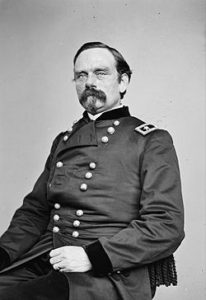 Peter Joseph Osterhaus (January 4, 1823 – January 2, 1917) was a German-American Union Army general in the American Civil War and later served as a diplomat.[1]
Peter Joseph Osterhaus (January 4, 1823 – January 2, 1917) was a German-American Union Army general in the American Civil War and later served as a diplomat.[1]
At the outbreak of the Civil War Osterhaus was appointed a major of the 2nd Missouri Volunteer Infantry and during the first year of the war was employed in Missouri and Arkansas, where he took a conspicuous part in the Battle of Wilson’s Creek and Battle of Pea Ridge. At Pea Ridge he commanded the troops that first made contact with Confederate forces advancing on the Union left. He was promoted to brigadier general on June 9, 1862. In 1863 he commanded a division in the Battle of Port Gibson, where he displayed tactical ability in prying Confederate defenders out of a favorable position.
Osterhaus continued in division command during the Vicksburg Campaign, fighting in the Battle of Champion Hill and at the Battle of Big Black River Bridge, where he was slightly wounded. Osterhaus’s division made an unsuccessful first attack on the defenses of Vicksburg, the first act of the Siege of Vicksburg. His division helped cover the siege against intervention by the Confederate forces of Gen. Joseph E. Johnston, and he took part in Maj. Gen. William T. Sherman’s advance on Jackson, Mississippi, that was designed to protect the rear of the Army of the Tennessee in its siege operations.
After the fall of Vicksburg, Osterhaus’s division was transferred to Tennessee. In the Chattanooga Campaign he aided Maj. Gen. Joseph Hooker in the capture of Lookout Mountain. Osterhaus then participated in the Atlanta Campaign but a month-long sick leave caused him to miss the crucial Battle of Atlanta. However, he returned to command and played a significant role in the Battle of Jonesborough. After the capture of Atlanta, he received command of the XV Corps, one of the four corps into which the army was consolidated, in the Sherman’s March to the Sea. In March 1865 Osterhaus was appointed chief of staff in the Military Division of West Mississippi under the command of Maj. Gen. Edward Canby, a commander with little combat experience in high command. Osterhaus served Canby through the battles of Spanish Fort and Fort Blakely. When Edmund Kirby Smith surrendered the Confederate forces in the Trans-Mississippi Theater, Osterhaus was sent as Canby’s representative and therefore personally signed the documents on behalf of the Union army.[3]
Content retrieved from: https://en.wikipedia.org/wiki/Peter_Joseph_Osterhaus.